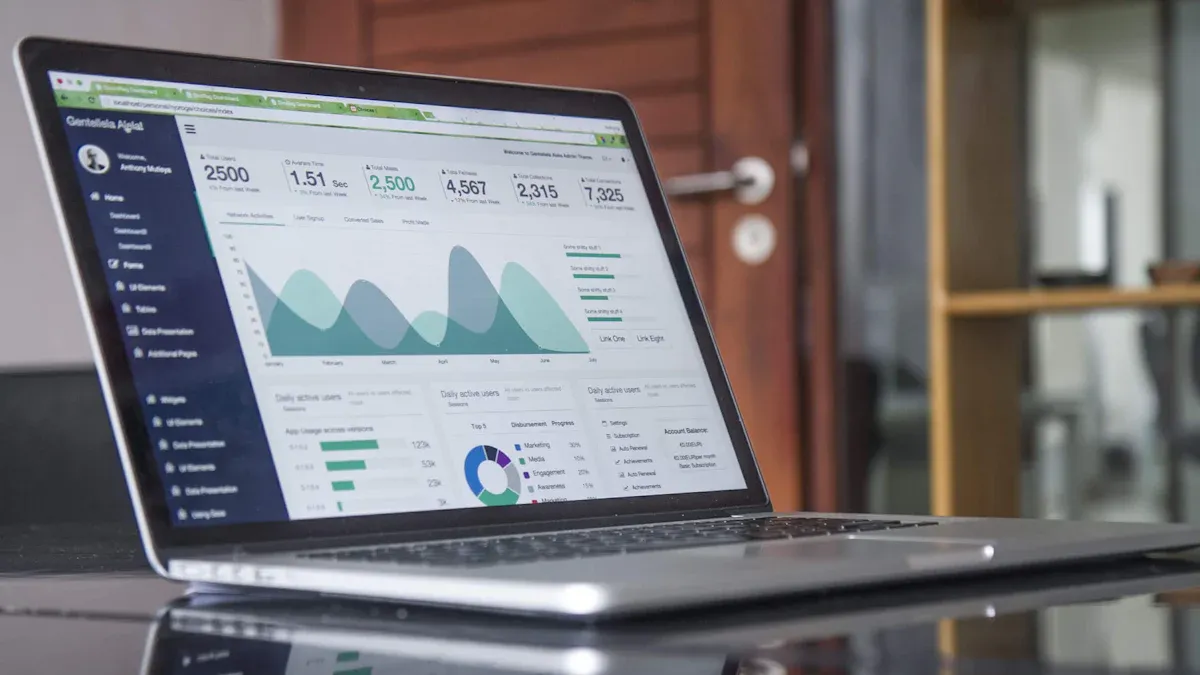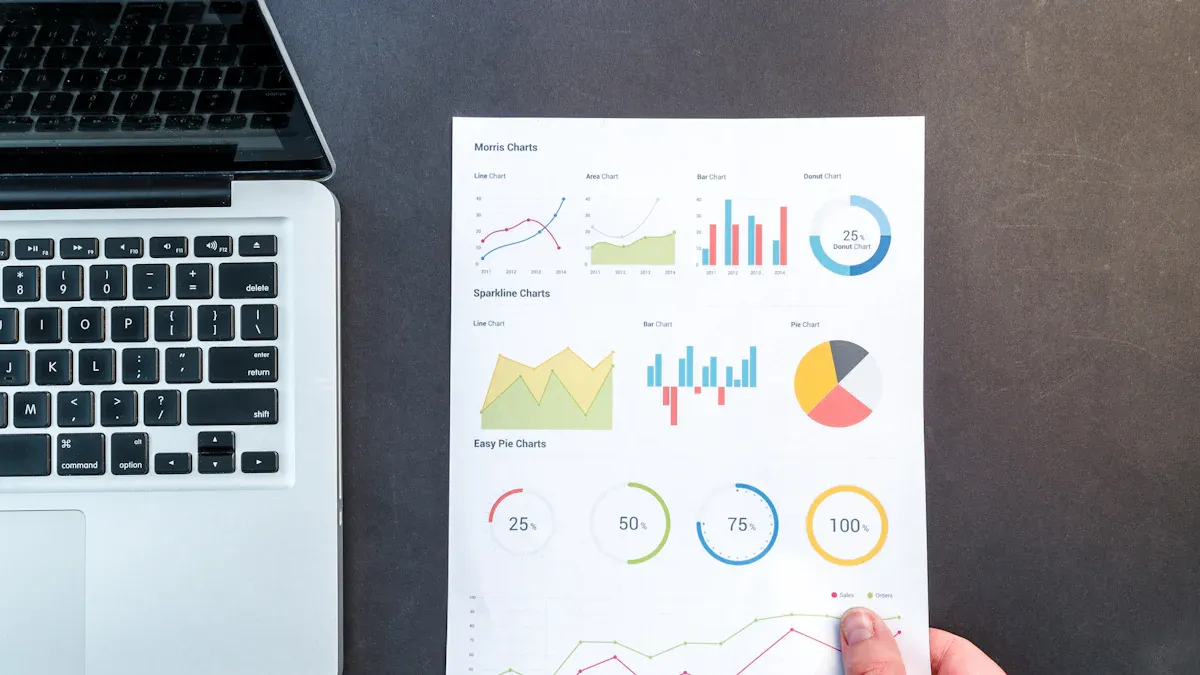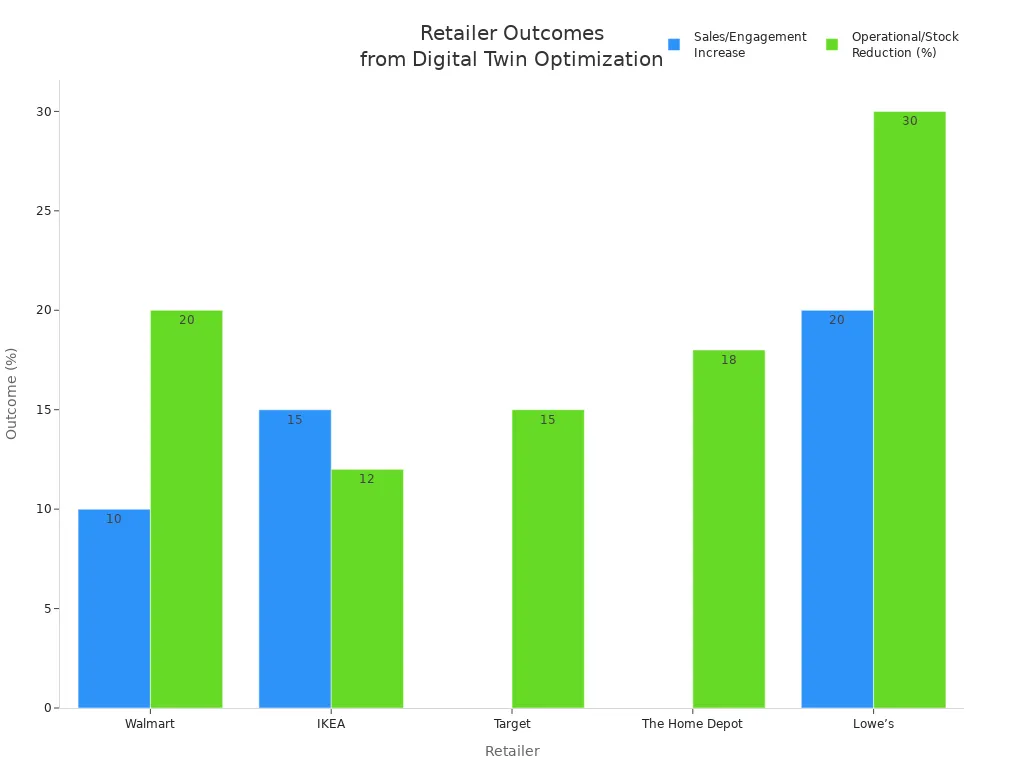Becoming Retail-Driven: How Data and Digital Twins Transform Decision-Making

You can make smarter choices in retail when you use data and digital twins. These tools help you respond faster and with better accuracy. Retailers now use real-time data and AI to predict what shoppers want and keep shelves stocked. The shift to a Retail-Driven approach shows in recent industry research:
Evidence Type | Details |
|---|---|
Adoption Shift | Retailers are moving from a mass-market approach to a personalized, data-driven strategy. |
Growth Rate | The industry has faced stagnant growth with a compound annual growth rate of 1.5% to 3.5%. |
AI Integration | 70% of retail executives expect to have AI capabilities in place within the year. |
Consumer Expectations | 6 in 10 retail buyers noted AI tools improved demand forecasting and inventory management. |
Key Takeaways
Using data and digital twins helps retailers make smarter decisions and respond quickly to customer needs.
Retail-Driven decision-making focuses on clear frameworks and data insights to improve store performance.
Digital twins allow you to test store layouts and product placements virtually, saving time and reducing costs.
Real-time data integration enhances supply chain management, helping retailers keep shelves stocked and reduce waste.
Starting small with digital twins can lead to significant improvements in customer experience and operational efficiency.
Retail-Driven Decisions

Retail-Driven decision-making means you use clear frameworks and data to guide your choices. You focus on what matters most for your store and your customers. This approach helps you stay competitive and meet changing demands. You can see the main characteristics of Retail-Driven decision-making in the table below:
Characteristic | Description |
|---|---|
Structured Decision-Making Frameworks | You set clear, objective criteria for every decision. |
Data-Driven Insights | You rely on both recent and historical data to spot trends. |
Overcoming Cognitive Biases | You use strategies to reduce personal bias and improve decision quality. |
You get immediate data to act quickly and boost accountability. | |
Alignment with Strategic Objectives | You make sure every choice supports your store’s bigger goals. |
Retail-Driven strategies give you an edge in price, quality, and convenience. Price leadership helps you attract budget-conscious shoppers. Quality leadership, including great customer service, sets you apart. Convenience makes shopping easier for your customers.
Digital Twins in Retail
Digital twins create virtual copies of your store, products, or processes. You can test ideas in real time and predict what will happen before making changes. This saves time and money. You can use digital twins for design and planning, sales and marketing, and daily operations. Here are some common applications:
Design and planning: You build 3D virtual stores to try out new layouts.
Sales and marketing: You add 3D assets to your website to boost sales and lower returns.
Operations: You use digital twins for autonomous checkout and smart navigation.
Digital twins let you run simulations and spot problems before they affect your business. You get real-time insights that help you manage your supply chain, optimize inventory, and improve store layouts. You also reduce energy use and create better customer experiences.
Role of Data
Data powers digital twins and makes them accurate. You need product data, store layout data, and real-time external data like local traffic and weather. Inventory and warehouse management data also play a big role. When you integrate all this information, your digital twin reflects the real world. Real-time updates keep your models current and reliable. You can use data visualization to find patterns and trends. This helps you make decisions that lower costs and increase sales.
Tip: The more types of data you use, the more precise your digital twin becomes. Real-time updates and validation with real-world data lead to better predictions and smarter choices.
Applications
Store Layouts
You can use digital twins to design and test store layouts before making changes in the real world. This technology lets you see how customers move through your store and where they spend the most time. You can try different product placements and displays in a virtual space. This helps you find the best setup for sales and customer flow.
Digital twins let you:
Simulate moving product displays or changing store layouts without moving anything in the real store.
Analyze how customers behave and adjust product placements to improve their shopping experience.
Work with your team in a shared virtual model, so every store uses the same strategy.
Retailers like Walmart and IKEA have used digital twins to solve real challenges. The table below shows how some major retailers improved their operations with this technology:
Retailer | Industry | Challenge | Solution Description | Outcomes |
|---|---|---|---|---|
Walmart | Grocery and Retail | Managing a vast network of stores | Created a virtual representation of stores for real-time monitoring | Reduced out-of-stock incidents by 20%, improved store layouts leading to a 10% sales increase. |
IKEA | Furniture Retail | Reducing operational costs | Simulated store environments and customer interactions | Achieved a 15% increase in customer engagement, 12% reduction in operational costs. |
Target | Discount Retail | Enhancing supply chain visibility | Created a comprehensive view of supply chain and inventory management | Improved supply chain efficiency by 25%, 15% decrease in excess-stocking. |
The Home Depot | Home Improvement Retail | Balancing supply chain and inventory management | Enhanced supply chain visibility and streamlined inventory processes | 18% reduction in stockouts, improved customer navigation and reduced checkout times. |
Lowe’s | Home Improvement Retail | Enhancing customer experience | Monitored and optimized in-store assets, including tools and displays | Reduced equipment downtime by 30%, 20% increase in customer interaction and engagement. |

Digital twins help you avoid costly mistakes by letting you test ideas virtually. You can see what works best before making changes in your store.
Customer Experience
You can use digital twins to make shopping more personal and enjoyable. These virtual models let you see how customers interact with your store and products. You can spot problems, like high cart abandonment rates, and fix them quickly. Digital twins also help you collect feedback in real time, so you can adapt to what your customers want.
Some ways digital twins improve customer experience:
They let you create try-before-you-buy experiences with 3D product views and augmented reality.
You can model your target audience and see where they face problems in the shopping journey.
You can offer personalized recommendations and promotions based on customer behavior.
Digital twins use AI and IoT to build immersive shopping environments. You can set up virtual fitting rooms and predict what your customers need. This makes your store more interactive and keeps shoppers coming back.
Note: Digital twins help you manage inventory better and reduce costs, which means you can focus more on your customers.
Supply Chain
Digital twins give you a clear view of your entire supply chain. You can track products from the warehouse to the store shelf. This helps you respond to problems faster and keep your shelves stocked.
You can:
Integrate data from trucks, warehouses, and stores to get real-time updates.
Optimize logistics and reduce costs by finding the best routes and schedules.
Use virtual models to test new products and branding before launching them.
Improve inventory positioning, forecasting, and production planning.
Retail giants like Walmart use digital twins to forecast demand by looking at real-time sales, weather, and economic data. You can spot inefficiencies and fix them before they become big problems. Predictive maintenance lets you schedule repairs before equipment breaks down, reducing downtime and keeping your business running smoothly.
Tip: Digital twins help you create a single source of truth for your supply chain. You can make decisions faster and with more confidence.
Scenario Testing
You can use digital twins to run "what-if" scenarios and see how changes might affect your business. For example, a quick service restaurant chain used a digital twin to test different ways to handle customer orders and payments. This helped them find the best setup for speed and customer satisfaction.
With scenario testing, you can:
Simulate customer traffic and shopping behaviors to see what works best.
Test new strategies and layouts without risking real-world problems.
Protect customer data while still offering personalized experiences.
Virtual site visits let you try out new store layouts and product placements without moving anything in the real world. You can use AI-driven insights to make better decisions about promotions and inventory. This approach saves money and helps you avoid costly mistakes.
Scenario testing with digital twins supports a Retail-Driven approach. You can adapt quickly to changes and keep your business ahead of the competition.
Implementation
Technologies
You need the right technology to build digital twins in retail. These tools help you create accurate models and make smart decisions. Here is a table showing the main technologies you will use:
Technology | Description |
|---|---|
AI | Powers real-time analysis and decision-making through algorithms that interpret data from digital twins. |
Data Collection | Uses sensors and IoT devices to gather data from your stores and products. |
Real-time Analysis | Gives you instant insights and helps you adjust quickly. |
Simulation Tools | Lets you build 3D models and test ideas before making changes in your store. |
Communication Infrastructure | Connects your physical stores to digital models using IoT and 5G for fast data sharing. |
These technologies work together to support a Retail-Driven approach. You can see what is happening in your stores and act fast.
Steps
You can follow these steps to start using digital twins in your retail business:
Define clear goals and decide what you want to improve.
Check if your data and systems are ready for digital twins.
Involve your team and other stakeholders early.
Make a plan for building and testing your digital twin.
Choose the best digital platform for your needs.
Map and connect your data sources.
Build your digital model.
Run simulations to test different ideas.
Keep improving your model with new data.
Train your team and manage changes.
Make sure your data is safe and follows rules.
Review your results and update your strategy.
Tip: Start small and grow your digital twin project step by step. This helps you learn and adjust as you go.
Challenges
You may face some challenges when you set up digital twins. Here are the most common ones and how you can solve them:
Challenge | Implication |
|---|---|
Limitations in data integration | Can cause mistakes and slow down your operations. |
Need for real-time data | Requires lots of sensors and devices to keep your model accurate. |
Cybersecurity concerns | Makes your data a target for hackers, so you need strong protection. |
Needs a big investment at the start for setup and maintenance. |
Many retailers struggle with data integration. About 78% say this is a major obstacle. You can fix this by setting clear data standards and using strong data infrastructure like data lakes and APIs. Data quality is also important. Use data cleansing and regular checks to keep your digital twin reliable.
Note: Training your team and protecting your data are key steps for success.
Future Trends

Innovations
You will see many new trends shaping the future of digital twins in retail. These trends help you make smarter choices and improve your store’s performance. The table below shows some of the most important trends:
Trend | Description |
|---|---|
Integration of AI | AI makes digital twins smarter, helping you predict what will happen and make better decisions. |
Digital Twins of Organizations | You can create digital twins for your whole business, not just one store or product. |
Convergence with the Metaverse | Digital twins connect with the metaverse, giving you new ways to create fun and immersive shopping experiences. |
Importance of Sustainability | You can use digital twins to track and improve your store’s impact on the environment. |
Testing Environments | You can test new ideas and products in a virtual space before making changes in your real store. |
Digital twins let you forecast demand, test store layouts, and try new pricing strategies. You can see how customers move through your store and what products they like. This helps you create a better shopping experience and increase sales. Retailers using AI and machine learning have seen their sales and profits grow more than twice as fast as others. Companies like Tapestry and Levi Strauss & Co. use data to understand customers and improve inventory. These innovations make your Retail-Driven strategy stronger.
Preparing for Change
You need to get ready for ongoing changes in digital twin and data technology. Start by using digital twins for scenario testing. This helps you plan for problems and find new solutions. Try new ideas like virtual try-ons and personalized recommendations to keep customers happy. Monitor your stock levels and use predictive maintenance to keep your equipment running.
Here are some steps you can take:
Use digital twins to test different store layouts and customer flows.
Engage your customers with new technology, such as virtual fitting rooms.
Track inventory in real time and predict what you will need next.
Train your team to use new tools and keep your data safe.
Retailers like Nike, Walmart, and Amazon already use digital twins to personalize shopping, save energy, and keep shelves stocked. You can follow their lead to stay ahead. As data-driven technologies grow, focus on real-time decision-making and advanced analytics. This will help you respond quickly to market changes and keep your Retail-Driven approach strong.
Tip: Stay curious and keep learning about new technology. This will help you adapt and succeed in the future of retail.
You can transform your store with a Retail-Driven approach by using data and digital twins.
The impact of digital twins on decision-making processes cannot be overstated, as they enhance live monitoring, scenario planning, and risk mitigation.
Digital twin technology allows businesses to make data-driven decisions with unprecedented confidence by converting complex data into actionable insights.
The digital twin director of a media and telecommunications company discussed creating digital twins of different customer groups to develop more targeted marketing strategies.
To get started, you can:
Deploy monitoring tools for data accuracy
Create dashboards for operational metrics
Train your team on ethical data use
Build scalable data pipelines
Set a goal to unify most of your enterprise data
You will stay ahead as technology evolves and shape the future of retail.
FAQ
What is a digital twin in retail?
A digital twin is a virtual copy of your store, product, or process. You use it to test ideas, predict outcomes, and improve your business before making real changes.
How does data improve decision-making in retail?
You use data to spot trends, track inventory, and understand customer behavior. Data helps you make faster and smarter choices that boost sales and reduce costs.
Can small retailers use digital twins?
Yes, you can start with simple digital twins. You test store layouts or track inventory. Many tools offer easy setups for small businesses.
What challenges might you face with digital twins?
You may struggle with data integration, high costs, or keeping data safe. You solve these by using strong data systems, training your team, and protecting your information.
How do digital twins help with customer experience?
You create virtual shopping journeys. You see where customers need help. You offer personalized recommendations and make shopping easier.
Tip: Start small and learn as you go. Digital twins grow with your business.
See Also
The Future of Retail Lies in AI-Driven Stores
Understanding the Growth of AI-Enhanced Corner Shops
Transforming Online Retail Management with AI Tools
Smart Technology: The Revolution of Electronics Vending Machines
